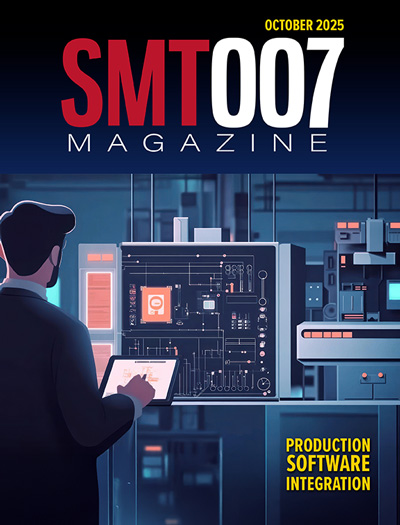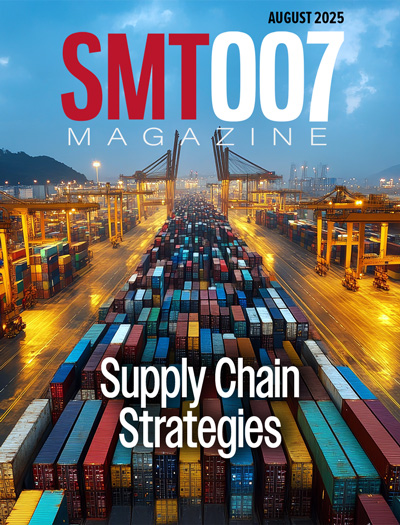-

- News
- Books
Featured Books
- smt007 Magazine
Latest Issues
Current Issue
Production Software Integration
EMS companies need advanced software systems to thrive and compete. But these systems require significant effort to integrate and deploy. What is the reality, and how can we make it easier for everyone?

Spotlight on India
We invite you on a virtual tour of India’s thriving ecosystem, guided by the Global Electronics Association’s India office staff, who share their insights into the region’s growth and opportunities.

Supply Chain Strategies
A successful brand is built on strong customer relationships—anchored by a well-orchestrated supply chain at its core. This month, we look at how managing your supply chain directly influences customer perception.
- Articles
- Columns
- Links
- Media kit
||| MENU - smt007 Magazine
Are Firms Holding Too Much Inventory?
October 30, 2024 | Shawn DuBravac, IPCEstimated reading time: 1 minute
In the aftermath of the 2008 financial crisis, manufacturers made significant adjustments to inventory management strategies as they faced sharp declines in demand and economic uncertainty. Manufacturers moved to scale back production and attempted to quickly reduce inventory levels. Post-crisis, many manufacturers adopted lean inventory practices, such as just-in-time (JIT) production, to minimize holding costs and illiquidity risks.
The crisis highlighted the risks of large inventories during periods of volatile demand and price fluctuations, prompting a greater focus on supply chain efficiency. While some sectors recovered quickly, others—particularly those reliant on consumer spending and credit markets, such as automotive and durable goods—experienced a slower rebound. Manufacturers remained cautious about overstocking, and inventory restocking was gradual and deliberate, aligning more closely with demand to create a responsive and flexible supply chain.
The lean inventory strategies adopted post-2008 had significant consequences during the COVID-19 pandemic. The JIT model, which minimizes on-hand inventory, left many manufacturers vulnerable to the widespread disruptions caused by lockdowns, factory shutdowns, and transportation delays. As a result, industries like medical supplies, electronics, and automotive components faced severe shortages. Long global supply chains, especially for critical components, exacerbated the situation. With no buffer stock, many manufacturers were forced to halt production.
In the initial aftermath of the pandemic, demand surged for certain products, such as home electronics and medical devices, while demand plummeted for others, such as automobiles and fashion. This rapid shift created both overstocking and understocking across sectors. Uncertainty amplified demand forecasting errors, leading manufacturers to over-order to avoid shortages and exacerbating manufacturing bottlenecks.
To read the rest of this article in the Fall 2024 issue of IPC Community, click here.
Testimonial
"Our marketing partnership with I-Connect007 is already delivering. Just a day after our press release went live, we received a direct inquiry about our updated products!"
Rachael Temple - AlltematedSuggested Items
Koh Young Discussing Ways to Apply Smart Factory Insights to Maximizing Productivity at SMTA Tijuana
10/14/2025 | Koh YoungKoh Young, the industry leader in True 3D measurement-based inspection solutions, will present at the SMTA Tijuana Expo & Tech Forum on November 13, 2025, at the Quartz Hotel in Tijuana, Baja California.
NEDME Returns October 22 — The Northwest’s Premier Design & Manufacturing Expo
10/13/2025 | NEDMEThe Northwest Electronics Design & Manufacturing Expo (NEDME) returns on Wednesday, October 22, 2025, at Wingspan Event & Conference Center, Hillsboro. The event brings together engineers, product designers, manufacturers, educators, and community partners for a full day of industry connection, learning, and networking.
Tight Upstream Supply and Restocking Drive 2024 DRAM Module Revenue Growth of 7%
09/30/2025 | TrendForceTrendForce reports that following the completion of inventory digestion in the downstream consumer market concluded at the end of Q4 2023, DRAM suppliers shifted focus towards HBM and server DDR5 products, leading to tighter supply for other DRAM types.
Looking to Reduce Your Consumables Spend? Visit ROCKA Solutions at SMTA International
09/29/2025 | ROCKA SolutionsROCKA Solutions, a trusted North American manufacturer and distributor of high-quality consumables for the electronics manufacturing industry, is pleased to announce its participation at SMTA International 2025, taking place October 19–23, 2025, at the Donald E. Stephens Convention Center in Rosemont, Illinois. Attendees can connect with the ROCKA team at Booth #2413.
Nordson Electronics Solutions Enables Seamless Integration of Actnano PFAS-Free Coatings With Asymtek Select Coat Conformal Coating Systems
09/23/2025 | Nordson Electronics SolutionsNordson Electronics Solutions, a global leader in reliable electronics manufacturing technologies, announces full compatibility of its industry-leading ASYMTEK conformal coating systems with actnano’s next-generation, PFAS-free materials.


